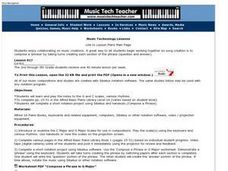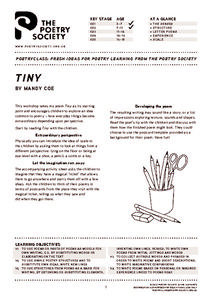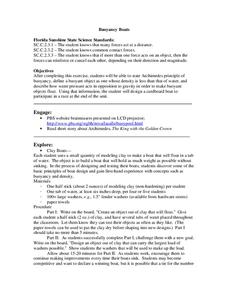Curated OER
Student Exploration: Weight and Mass
In this student exploration-weight and mass worksheet, student use the Weight and Mass Gizmo to answer questions and fill in charts with estimating and measuring.
Curated OER
BOLTSS Map
In this geography worksheet, students identify the six features always used on maps. They identify each of these features by the acronym BOLTSS. Students examine the Melbourne Cricket Ground shown and respond to the 4 questions that follow.
Curated OER
Destruction by Earthquakes
In this earthquakes worksheet, students will name the parts of a seismograph and then review information about large magnitude earthquakes that have occurred. This worksheet has 4 fill in the blank and 7 short answer questions.
Pennsylvania Department of Education
The Weight of Things
Learners explore weight. In this math lesson, students predict which item weighs more and discuss how they arrived at their decision. Learners weigh several items to determine which weighs more.
Curated OER
Music Creations
Students practice playing notes on the G and C scales in different rhythms. They complete worksheets and discuss the answers. They finish a short notation project as well.
Curated OER
Kelvin Temperature Scale
In this Kelvin temperature worksheet, students write Celsius degrees and Kelvin temperatures and vice versa. Students complete 17 problems.
Curated OER
Translations and Scale Changes
Students perform translation and transformation of functions. For this algebra lesson, students write the formula for the different transformation and graph given translation. They compare the change to the parent function.
EngageNY
Mid-Module Assessment Task - Geometry (Module 2)
Challenge: create an assessment that features higher level thinking from beginning to end. A ready-made test assesses knowledge of dilations using performance tasks. Every question requires a developed written response.
Balanced Assessment
Ford and Ferrari
Which is faster, a Ford or a Ferrari? The short assessment has pupils analyze graphs to determine the rates of change between the two. Individuals interpret the rates of change within the context of speeds of the cars and develop a map...
EngageNY
End-of-Module Assessment Task - Grade 8 Mathematics (Module 3)
Everything the class knows about similarity in one small package. The last portion of a 16-part series is a three-question assessment. In it, pupils demonstrate their application of similar figures and their associated...
Poetry Society
Tiny by Mandy Coe
Introduce magic and imagination into your classroom with a poetry activity. Learners read the poem "Tiny" by Mandy Coe and use their magic tickets to visit any place they can think of! The final result is a poem describing where they...
Inside Mathematics
Hopewell Geometry
The Hopewell people of the central Ohio Valley used right triangles in the construction of earthworks. Pupils use the Pythagorean Theorem to determine missing dimensions of right triangles used by the Hopewell people. The assessment task...
Illustrative Mathematics
Running Around a Track I
The accuracy required by the design and measurement of an Olympic running track will surprise track stars and couch potatoes alike. Given a short introduction, the class then scaffolds into a detailed analysis of the exact nature of the...
Science Matters
Finding the Epicenter
The epicenter is the point on the ground above the initial point of rupture. The 10th lesson in a series of 20 encourages scholars to learn to triangulate the epicenter of an earthquake based on the arrival times of p waves and s...
Noyce Foundation
Surrounded and Covered
What effect does changing the perimeter have on the area of a figure? The five problems in the resource explore this question at various grade levels. Elementary problems focus on the perimeter of rectangles and irregular figures with...
EngageNY
Volume and Surface Area II
Determine the cost of projects based on volume or surface area. Pupils work problems to determine the cost of building a brick planter and a stainless steel feeder in the 27th installment of a 28-part series. Participants must consider...
Curated OER
Temperature Calculation
In this temperature conversion worksheet, young scholars use the formulas of converting Celsius to Fahrenheit and Fahrenheit to Celsius to calculate the temperature in given problems.
Curated OER
Science Jeopardy - The Earth Sciences
The earth sciences are the focus for this Jeopardy-style review game. Categories include geology, space, scientific investigation, meteorology, and oceanography. Diagrams and pictures are involved with most of the questions, making this...
Center for Precollegiate Education and Training
Buoyancy Boats
What did the sea say to the boat? Nothing, it just waved. An inquiry-based lesson starts with a simple concept on the Archimedes Principle and challenges pupils to make something out of clay that floats. Then, they design...
DiscoverE
Water Pollution Cleanup
How do scientists determine the best method for removing pollutants from our water sources? Environmental scholars experiment with pollution clean-up options to discover which are the most cost-effective, fastest, and most thorough....
Curated OER
Lines & Spaces; Another Round
Fourth graders recall the letter names of the notes of the C-major scale and identify the names of the C-major scale. They identify the names of the lines and spaces on a music staff. They sing rounds.
Curated OER
Planning a Healthy City
Ninth graders create a scaled model city. They create a blueprint that provides for the economic and cultural needs of a community. They identify where essential elements of the city should be located and explain the rationale for the...
Curated OER
Lesson Plan Project
Learners demonstrate the composing of a string quartet piece by working together in small groups to write a short composition based around a pentatonic scale for all four instruments. They evaluate their peers compositions by...
Curated OER
Probability
In this probability instructional activity, 6th graders solve and complete 3 different problems. First, they place the events on the probability scale shown. Then, students match the phrase to the best description of its chance of...























